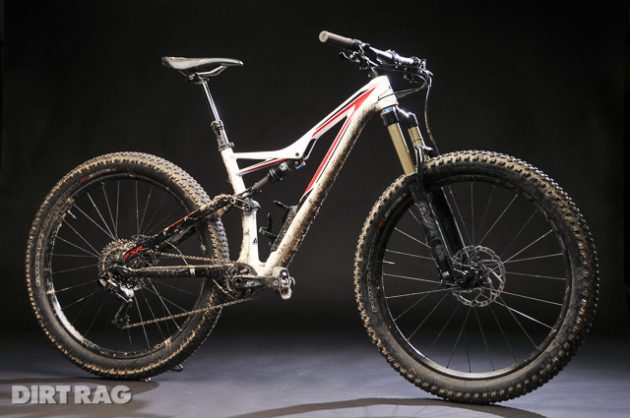Review: Specialized Stumpjumper FSR faceoff
Originally posted on June 3, 2016 at 7:00 am
Photos: Justin Steiner
Graphic: Stephen Haynes
As of this writing, very few manufacturers offer 27.5, 27plus and 29 inch wheels within one model lineup, but Specialized has embraced wheel size options big time for 2016. The venerable Stumpjumper FSR is available in 14 complete builds and five frame-only options across all three wheel sizes. Complete bikes range from $2,900 to $8,600, while frames range from $3,000 to $4,500.
The Bikes
All of the Stumpjumper FSR models were entirely redesigned for the 2016 model year. Geometry is now slacker and more aggressive, in line with where the previous EVO models were positioned. With this change, the EVO models have been removed from the lineup.
The Comp Carbon 650B utilizes a unique carbon front triangle and aluminum swingarm, where the Comp Carbon 6Fattie and Expert 29 models share a carbon front triangle, but are mated to different aluminum swingarms. The 27plus bike utilizes Boost hub spacing front and rear, while the 27.5 and 29 bikes use 142 mm spacing in the rear and 100 mm fork spacing.
All Stumpjumper models now offer significantly shorter chainstays thanks to the Taco Blade front derailleur mount first introduced on the Enduro 29. The 29er’s stays shrink from 17.7 inches to 17.2 inches, while the 27.5 bike drops from 17.1 inches to a short 16.5 inches. The 6Fattie mirrors the 17.2 inch chainstays of the 29er.
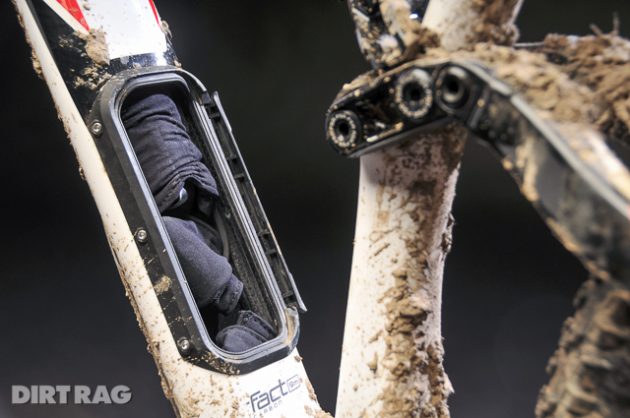
For 2016, Specialized is pushing its SWAT (Storage, Water, Air, Tools) concept even further with the introduction of the SWAT Door on all carbon frames. This ingenious removable door is located underneath the water bottle cage, opening up the entire downtube for storage of tubes, tools and anything else you might want.
Specialized includes a tube inside a protective wrap and a small tool roll, sans tools. Even though both of us usually ride with a pack, we find this storage option an awesome way to take advantage of underutilized space.
All three bikes include Specialized’s newest dropper: Command Post IRcc. Small-sized frames get 100 mm of travel, while all larger sizes offer 125 mm of movement. This cable-actuated post features internal routing and offers two remote options. One: for use with a front shifter, and the SRL remote, which mounts in place of the shifter for use with single-ring drivetrains. The “cc” designation in the name stands for “Cruiser Control” technology. Instead of having three positions, this mechanically-locking post offers ten positions throughout the travel. We greatly appreciate the extra positions, but found hitting them reliably somewhat difficult. These posts held up well in cold weather, but their return slowed in sub-freezing conditions.
The Testers
- William Kirk; Age: 32 Weight: 185 lbs. Height: 5’ 9” Inseam: 31”
- Justin Steiner; Age: 33 Weight: 165 lbs. Height: 5’ 7” Inseam: 31”
Specialized Stumpjumper FSR Comp Carbon 650B
Price: $3,800
Sizes: S, M (tested), L, XL
Our Comp-level test bike is the least expensive of the group at $3,800, but is smartly spec’d. Deore brakes sacrifice very little performance compared to their pricey siblings, though we did miss tool-free reach adjustment. A 150 mm travel RockShox Revelation steps in for the Pike found on more expensive models. The Revelation is a good fork, but its 32 mm stanchions aren’t always able to keep pace with the rest of the bike in terms of stiffness.
As awesome as 1×11 drivetrains are, the mixed Shimano and SRAM 2×10 drivetrain worked very well after we re-acclimated to shifting a front derailleur. However, William would much prefer a single-ring drivetrain, both in terms of drivetrain simplicity and to accommodate the SRL dropper post lever, even if that resulted in a 10-speed setup (rather than SRAM’s dedicated 11-speed) to hit this price point.
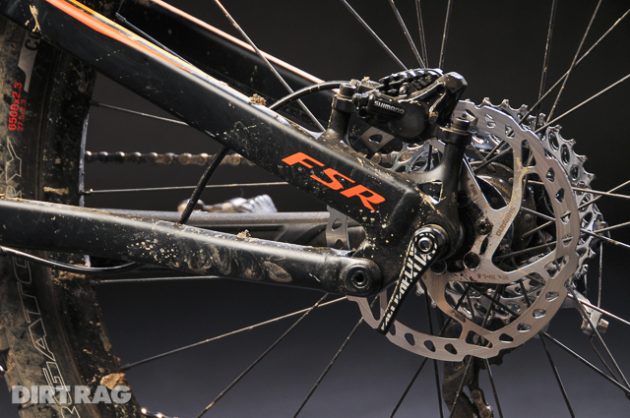
This bike comes with a great set of tires. Specialized’s Butcher front and Purgatory rear combo is simply stellar. They roll well, bite hard and break away predictably. In general, the “budget” Comp’s component performance isn’t nearly as far behind that of the Expert-level 29er as the $2,100 price difference might lead you to believe.
This is the most agile of the three Stumpys. The short chainstays make for a wheelie- and manual-happy bike that frolics down the trail, dodging in and out of turns, boosting jumps and popping trail features at every opportunity. It also offers the shortest front center by 0.3 inches, resulting in a wheelbase 0.9 inches shorter than the 6Fattie and 0.7 inches shorter than the 29er. Yet, with a 67 degree head tube angle and a 13.2 inch bottom bracket height there’s ample stability. The result is a lively and neutral handling bike that splits the difference between the steeper and slacker bikes in the 150 mm trail bike category.

All of these Stumpys have a distinctly-Specialized suspension feel, but the 27.5 bike is the softest of the trio, largely due to the additional travel. The initial stroke is very supple, the bike is eager to get into the mid-stroke and it’s also not afraid to bottom out. We found the spring rate of the Fox Float Evolution CTD shock on the 27.5 to be a little on the soft side in terms of bottom-out resistance and mid-stroke support, particularly in descend mode. Trail mode’s additional damping helped the issue, but ultimately we’d reduce the air volume in the rear shock to provide a slightly more progressive spring curve. The Climb setting was very usable, firming things up while allowing enough compliance to maintain traction.
- Reach: 16.3”
- Stack: 23.6”
- Top Tube: 23.1”
- Head Tube: 67º
- Seat Tube: 74º
- BB height: 13.2”
- Chainstays: 16.5”
- Wheelbase: 44.3”
- Weight: 29.4 lbs. w/o pedals (specs based on size tested)
Specialized Stumpjumper FSR Comp Carbon 6fattie
Price: $4,500
Sizes: S, M (tested), L, XL
The 6Fattie’s $4,500 price tag sits in the middle of this trio. Though it shares the “Comp” model designation with the 27.5 bike reviewed, the price bump buys you a SRAM 1×11 GX drivetrain, a 150 mm travel Fox 34 Plus Performance fork and those plus-sized tires.
With the longest wheelbase of the bunch, it’s no surprise the 6Fattie is the most stable of this group. Though the wheelbase isn’t long, per se, it combines with the additional gyroscopic inertia of those big tires to provide a lot of straight-line stability. When it comes time to change directions, the 6Fattie requires much more effort than the 27.5 model and slightly more effort than the 29er. The good news is that you don’t need to change direction as much because this bike rolls over and through the roughest terrain without breaking a sweat.

It is absolutely vital to manage tire pressure accurately. We found the sweet spot to be in the 18-19 psi range. Flirting with 20-22 psi decreased traction but increased casing stability and bounce. Much below 18 psi, the tires squirm more in high-load situations such as g-outs and corners. In general, firm terrain with a lot of grip is the weakest area of performance for this particular tire and rim combination.
These tires have a ton of grip, so when the trail surface also offers ample grip the tread traction can overwhelm the sidewalls of the tires, causing them to roll, squirm and exhibit some self-steering. On the other hand, the looser the trail surface the better. From leaf-covered trails to spongy trails to snow, the additional flotation, stability and grip was a huge benefit.
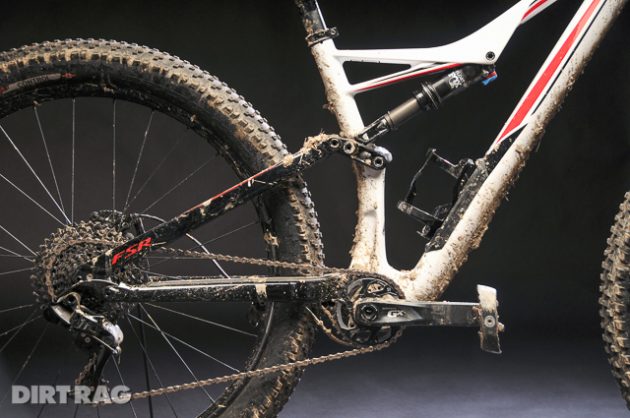
The worse trail conditions became, with the exception of sticky mud, the more the 6Fattie distanced itself from its siblings. Similar story in slow, rock crawling situations. Those big tires were able to conform to the rocks, providing epic traction and making any line just a little bit easier. We can’t help but speculate that rims wider than the stock, 29 mm internal width Roval Traverse would better support the plus tires and improve performance in all conditions as well as minimize some of its less flattering attributes.
While the 6Fattie didn’t mind bottoming out, it was less harsh and less frequent than aboard the 27.5 bike. Particularly when combined with the softness of the big tires, the 6Fattie’s 135 mm of rear travel felt more plush than the 29er.

Up front, the Fox 34 Plus Performance fork is a big step forward for the 34 chassis. The new air spring, with self-balancing positive and negative chambers, felt great. The new FIT4 damping also felt like a huge improvement, providing more low-speed compression support in Descend mode, while still offering good sensitivity. Very low friction, good small bump performance, as well as solid mid-stroke support and good ramp up to bottom out make for a very high-functioning fork.
- Reach: 16.3”
- Stack: 24.3”
- Top Tube: 23.2”
- Head Tube: 67º
- Seat Tube: 74º
- BB height: 13.0”
- Chainstays: 17.2”
- Wheelbase: 45.2”
- Weight: 30.1 lbs. w/o pedals (specs based on size tested)

Specialized Stumpjumper FSR Expert 29
Price: $5,900
Sizes: XS, S, M (tested), L, XL
Our Expert-trim 29 inch model is the ringer in terms of price and parts spec. With a price tag of $5,900, its spec is at least one model notch above the other two bikes: SRAM’s X1 drivetrain compared to GX on the 6Fattie, and Shimano XT brakes compared to SLX and Deore offerings. The 140 mm travel RockShox Pike on the 29er adds a lot of confidence in terms of stiffness. Neither William nor Justin felt the RC damper gave up anything compared to the RCT3 model. But, both felt the Pike could use one additional volume spacer to provide more spring rate ramp-up.

On paper, the geometry of the 29 inch Stumpy is fairly similar to that of the 6Fattie, with a head tube angle only 0.5 degrees steeper and a resulting front center 0.2 inches shorter. On the trail, the ride feel differs more than those slight variations might suggest. The 29er changes directions with less effort than the 6Fattie, particularly at higher speeds. On dry hardpack, it’s more predictable at higher speeds due to the lack of tire squirm. In moderately sloppy or loose conditions, it holds its own well against the 6Fattie, but doesn’t have the flotation to keep up in deeper snow, sand or soft trails.
This big-wheeled steed is by far the most efficient of the group for covering ground in technical terrain under good trail conditions. Big wheels roll over rocks and roots almost as well as 27plus, but provide ample tire support for aggressive riding in high-load situations. The longer chainstays of the 29er and 6Fattie require noticeably more effort to loft the front but provide added stability at speed.
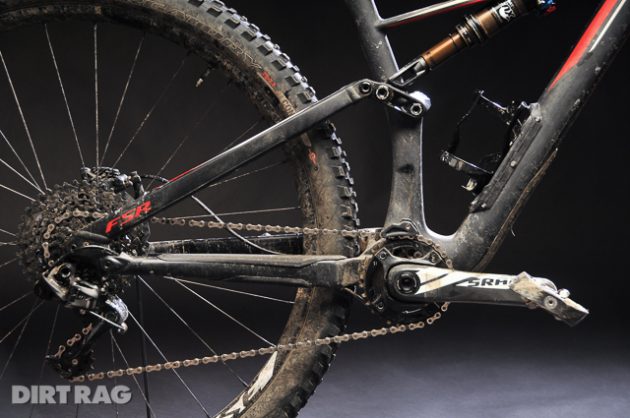
Suspension tuning on the 135 mm travel Fox Float Factory CTD shock feels the firmest of the bunch on the 29er, adding to the feeling of effi ciency. The pedaling platform is more supportive, yielding far less pedal-induced motion. On the 29er, AutoSag was a little too firm, yielding just under 20 percent sag.
- Reach: 16.4”
- Stack: 24.3”
- Top Tube: 23.4”
- Head Tube: 67.5º
- Seat Tube: 74º
- BB height: 13.2”
- Chainstays: 17.2”
- Wheelbase: 45.0”
- Weight: 28.1 lbs. w/o pedals (specs based on size tested)
Bikes Compared
27.5: The Playful Spirit
The 27.5 is the playbike of this group by a margin, but it’s no one-trick pony. William found it to balance climbing and descending very well, saying he had more fun on this bike than he’s had on a bike in a long time. No surprise, this is the bike William would buy out of this group. On the other hand Justin felt the 27.5’s liveliness was thrilling when you wanted to throw the bike around, but required more work to ride in really rough and technical terrain. At the end of a grueling day in the saddle, he’d rather be on one of the other bikes.
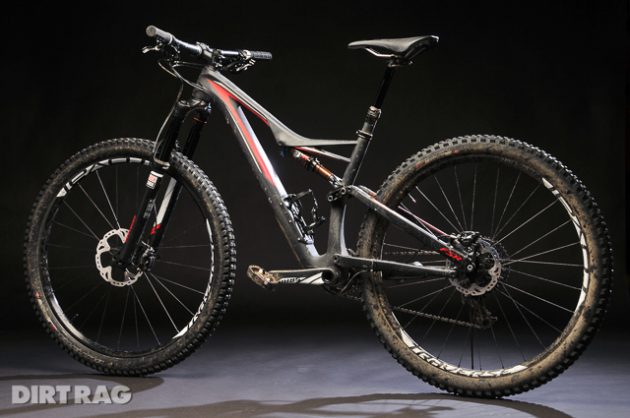
29: Mileage Monster
William felt the 29er would be his choice for enduro race applications, short of the very aggressive courses where more travel and a much slacker head tube angle are necessary. It’s the rocket of the group when it comes to going fast. From Justin’s perspective, this is the bike you want to cover ground in rowdy backcountry terrain. Even though it might be less fun and requires more effort to loft the front wheel, he felt he could ride the 29er fastest of this group. That’s why the 29er would be Justin’s pick of this litter.

27plus: The Overland Explorer
For William, it’s easy to see merit in the plus concept, but admits it’s not for everyone. The 6Fattie is tailored for someone who rides aggressive terrain but rides light on his or her bike. Ultimately, tire pressure is always a compromise. Enough pressure to support the sidewalls compromised traction, and the optimal tire pressure for traction didn’t support the tire well enough. Justin thoroughly enjoyed his time aboard the 6Fattie but yearned for wider rims. If the 6Fattie was so equipped, he felt it would be the bike to buy. The 27plus platform gives you the freedom to swap in a set of 29 inch wheels when you don’t need the floatation and grip of the plus tires. This could truly be the best of both worlds for many riders.

